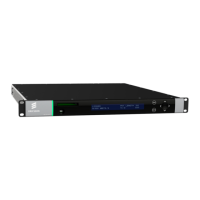Using the Equipment
• RIP Metric1 – RIP uses a single routing metric (hop count) to measure the
distance between the source and a destination network. Each hop in a path from
source to destination is assigned a hop-count value, which is typically 1. When a
router receives a routing update that contains a new or changed destination-
network entry, the router adds one to the metric value indicated in the update
and enters the network in the routing table. The IP address of the sender is used
as the next hop. This item provides a display of the first metric to be used.
• RIP Metric2 – RIP uses a single routing metric (hop count) to measure the
distance between the source and a destination network. Each hop in a path from
source to destination is assigned a hop-count value, which is typically 1. When a
router receives a routing update that contains a new or changed destination-
network entry, the router adds one to the metric value indicated in the update
and enters the network in the routing table. The IP address of the sender is used
as the next hop. This item provides a display of the second metric to be used.
• Timeout – Enables input of the timeout in seconds. A value of 0 means RIP
updates are disabled.
• Resume on Reboot – Checking this box enables RIP + TS resume on reboot.
3.18.4.7 Forward Error Correction (FEC)
FEC is intended to introduce redundancy in the output data stream, which can help
recover lost data on the IRD side. As the most common data loss on an IP network
is packet loss, FEC is intended to introduce redundancy through packets so that
whole packets can be restored if lost.
FEC uses a simple parity bit for redundancy. This is computed from n bit spread
through packets. In case of “row FEC”, a FEC packet is created from n consecutive
packets. Each bit of the FEC packet is computed from the corresponding bits of the
n packets, e.g. 1
st
bit is computed from the 1
st
bits of the n packets. Note that only
the payload of the packets is protected by the FEC packet, headers are ignored and
FEC packets have a FEC header.
In case of “column FEC” non-consecutive packets are protected with FEC packets
(interleaving). However, the offset between the packets are constant, which means,
drawn in a table they are in the same column.

